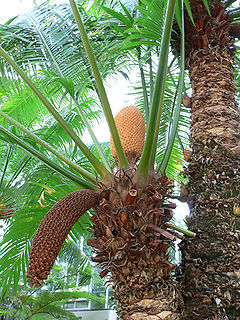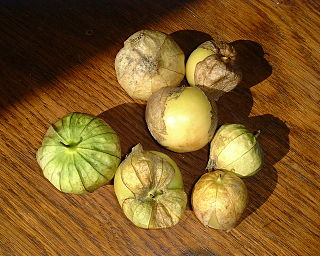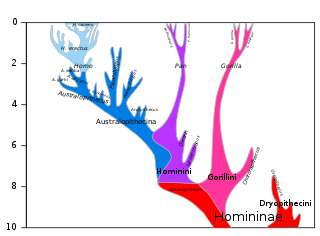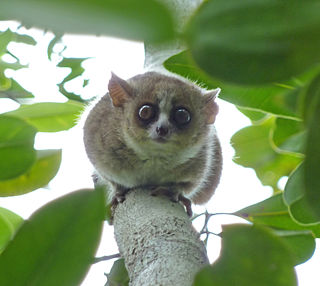
A fossil is any preserved remains, impression, or trace of any once-living thing from a past geological age. Examples include bones, shells, exoskeletons, stone imprints of animals or microbes, objects preserved in amber, hair, petrified wood, oil, coal, and DNA remnants. The totality of fossils is known as the fossil record.

Flowering plants are plants that bear flowers and fruits, and form the clade Angiospermae, commonly called angiosperms. The term "angiosperm" is derived from the Greek words angeion and sperma ('seed'), and refers to those plants that produce their seeds enclosed within a fruit. They are by far the most diverse group of land plants with 64 orders, 416 families, approximately 13,000 known genera and 300,000 known species. Angiosperms were formerly called Magnoliophyta.

Paleontology, also spelled palaeontology or palæontology, is the scientific study of life that existed prior to, and sometimes including, the start of the Holocene epoch. It includes the study of fossils to classify organisms and study their interactions with each other and their environments. Paleontological observations have been documented as far back as the 5th century BCE. The science became established in the 18th century as a result of Georges Cuvier's work on comparative anatomy, and developed rapidly in the 19th century. The term itself originates from Greek παλαιός, ὄν, and λόγος.

Australopithecus is a genus of early hominins that existed in Africa during the Late Pliocene and Early Pleistocene. The genus Homo emerged within Australopithecus, as sister to e.g. Australopithecus sediba. Also the genera Paranthropus and Kenyanthropus emerged within the Australopithecus. Australopithecus is a member of the subtribe Australopithecina, which sometimes also includes Ardipithecus, though the term "australopithecine" is sometimes used to refer only to members of Australopithecus. Species include A. garhi, A. africanus, A. sediba, A. afarensis, A. anamensis, A. bahrelghazali and A. deyiremeda. Debate exists as to whether some Australopithecus species should be reclassified into new genera, or if Paranthropus and Kenyanthropus are synonymous with Australopithecus, in part because of the taxonomic inconsistency.

Cycads are seed plants that typically have a stout and woody (ligneous) trunk with a crown of large, hard, stiff, evergreen and (usually) pinnate leaves. The species are dioecious, that is, individual plants of a species are either male or female. Cycads vary in size from having trunks only a few centimeters to several meters tall. They typically grow very slowly and live very long, with some specimens known to be as much as 1,000 years old. Because of their superficial resemblance, they are sometimes mistaken for palms or ferns, but they are not closely related to either group.

The molecular clock is a figurative term for a technique that uses the mutation rate of biomolecules to deduce the time in prehistory when two or more life forms diverged. The biomolecular data used for such calculations are usually nucleotide sequences for DNA, RNA, or amino acid sequences for proteins. The benchmarks for determining the mutation rate are often fossil or archaeological dates. The molecular clock was first tested in 1962 on the hemoglobin protein variants of various animals, and is commonly used in molecular evolution to estimate times of speciation or radiation. It is sometimes called a gene clock or an evolutionary clock.

A living fossil is an extant taxon that cosmetically resembles related species known only from the fossil record. To be considered a living fossil, the fossil species must be old relative to the time of origin of the extant clade. Living fossils commonly are of species-poor lineages, but they need not be. While the body plan of a living fossil remains superficially similar, it is never the same species as the remote relatives it resembles, because genetic drift would inevitably change its chromosomal structure.

The Caudata are a group of amphibians containing the salamanders (Urodela) and all extinct species of salamander-like amphibians more closely related to salamanders than to frogs. They are typically characterized by a superficially lizard-like appearance, with slender bodies, blunt snouts, short limbs projecting at right angles to the body, and the presence of a tail in both larvae and adults.

The tomatillo, also known as the Mexican husk tomato, is a plant of the nightshade family bearing small, spherical and green or green-purple fruit of the same name. Tomatillos originated in Mexico and were cultivated in the pre-Columbian era. A staple of Mexican cuisine, they are eaten raw and cooked in a variety of dishes, particularly salsa verde.

Physalis alkekengi, the bladder cherry, Chinese lantern, Japanese-lantern, strawberry groundcherry, or winter cherry, is a species of flowering plant in the nightshade family Solanaceae. It is a close relative of the new world Physalis peruviana. Unlike the rest of Physalis that is native to the Americas, this species is native to the regions covering Southern Europe to South Asia and Northeast Asia.

Physalis is a genus of flowering plants in the nightshade family (Solanaceae), which grow in warm temperate and subtropical regions of the world. Most of the species, of which there may be 75 to 90, are indigenous to the Americas. Cultivated species and weedy annuals have been introduced worldwide. A notable feature is the formation of a large, papery husk derived from the calyx, which partly or fully encloses the fruit. Some species bear edible fruit, which is small and yellow to orange, similar in size, shape, and structure to a small tomato. They are also grown as ornamental plants, and used in Chinese medicine.

Physalis peruviana, is a South American plant native to Colombia, Ecuador and Peru in the nightshade family (Solanaceae), commonly known as Cape gooseberry or goldenberry, known in its countries of origin as aguaymanto, uvilla or uchuva, in Hawaii called poha, and in Egypt called Harankash, in addition to numerous indigenous and regional names. The goldenberry is also known as ground cherry. The history of P. peruviana cultivation in South America can be traced to the Inca Empire. It has been cultivated in England since the late 18th century, and in South Africa in the Cape of Good Hope since at least the start of the 19th century. Widely introduced in the 20th century, P. peruviana is cultivated or grows wild across the world in temperate and tropical regions.

The evolution of the horse, a mammal of the family Equidae, occurred over a geologic time scale of 50 million years, transforming the small, dog-sized, forest-dwelling Eohippus into the modern horse. Paleozoologists have been able to piece together a more complete outline of the evolutionary lineage of the modern horse than of any other animal. Much of this evolution took place in North America, where horses originated but became extinct about 10,000 years ago.

The evolution of fungi has been going on since fungi diverged from other life around 1.5 billion years ago, with the glomaleans branching from the "higher fungi" at ~570 million years ago, according to DNA analysis. Fungi probably colonized the land during the Cambrian, over 500 million years ago,, and possibly 635 million years ago during the Ediacaran, but terrestrial fossils only become uncontroversial and common during the Devonian, 400 million years ago.

The Salientia are a total group of amphibians that includes the order Anura, the frogs and toads, and various extinct proto-frogs that are more closely related to the frogs than they are to the Urodela, the salamanders and newts. The oldest fossil "proto-frog" appeared in the early Triassic of Madagascar, but molecular clock dating suggests their origins may extend further back to the Permian, 265 million years ago.

The chimpanzee–human last common ancestor (CHLCA) is the last common ancestor shared by the extant Homo (human) and Pan genera of Hominini. Due to complex hybrid speciation, it is not currently possible to give a precise estimate on the age of this ancestral population. While "original divergence" between populations may have occurred as early as 13 million years ago (Miocene), hybridization may have been ongoing until as recently as 4 million years ago (Pliocene).

Lemurs, primates belonging to the suborder Strepsirrhini which branched off from other primates less than 63 million years ago, evolved on the island of Madagascar, for at least 40 million years. They share some traits with the most basal primates, and thus are often confused as being ancestral to modern monkeys, apes, and humans. Instead, they merely resemble ancestral primates.

The evolutionary history of the primates can be traced back 57-85/90 million years. One of the oldest known primate-like mammal species, Plesiadapis, came from North America; another, Archicebus, came from China. Other similar basal primates were widespread in Eurasia and Africa during the tropical conditions of the Paleocene and Eocene. Purgatorius is the genus of the four extinct species believed to be the earliest example of a primate or a proto-primate, a primatomorph precursor to the Plesiadapiformes, dating to as old as 66 million years ago.

The Solanaceae, or nightshades, are a family of flowering plants that ranges from annual and perennial herbs to vines, lianas, epiphytes, shrubs, and trees, and includes a number of agricultural crops, medicinal plants, spices, weeds, and ornamentals. Many members of the family contain potent alkaloids, and some are highly toxic, but many—including tomatoes, potatoes, eggplant, bell and chili peppers—are used as food. The family belongs to the order Solanales, in the asterid group and class Magnoliopsida (dicotyledons). The Solanaceae consists of about 98 genera and some 2,700 species, with a great diversity of habitats, morphology and ecology.

The earliest known life forms on Earth are putative fossilized microorganisms found in hydrothermal vent precipitates, considered to be about 3.42 billion years old. The earliest time that life forms first appeared on Earth is at least 3.77 billion years ago, possibly as early as 4.28 billion years, or even 4.41 billion years—not long after the oceans formed 4.5 billion years ago, and after the formation of the Earth 4.54 billion years ago. The earliest direct evidence of life on Earth is from microfossils of microorganisms permineralized in 3.465-billion-year-old Australian Apex chert rocks.



















